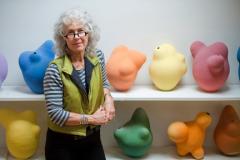The Role of Agency in a Unified Craft: Some Considerations
In recent years, theory in craft has devoted itself primarily to the subject of what craft is. Questions of its definition and development have almost invariably ended up at the art/craft dialectic, in which craft must continually seek to differentiate itself from art. In developing a unified theory of craft, we will be more successful if we consider instead what craft does, not what it is. Through an examination of craft's role as an agent in mediating the relationship of utility and aesthetics, we can develop a more meaningful and useful theory for practitioners and audiences.
The Problematic Nature of a Unified Theory
In many countries, including the United States, people have traditionally relied upon craft to signify their cultural identity, and they have valued-first as a resistance to industrialization, then as a resistance to globalization-the purity, the innocence and unworldliness of craft. In the effort to define a unified theory of craft, the most problematic part is lodged in the challenges of industrialization and globalization. Through trade, artists and craftpeople have had increasing access to the products of other cultures. In the past century, however, our exposure to other cultures has multiplied exponentially. Our awareness of the world and sense of our community have extended and enlarged. As we face the twenty-first century, none of us can claim that cultural innocence. Instead, our task is to weave coherence from a complex, tangled web of time and space to create a language that speaks across moments and borders.
Since culture determines values, aesthetics and attitudes, a unified theory of craft must be inclusive, serving a variety of cultures and facilitating the communication of those cultures through visual and tactile means. It will enable a recognition and appreciation of the value of craft in other systems, offer up a perspective of our own, and foster an understanding of how we confront, accept and incorporate the values, techniques and aesthetics of other cultures.
"Craftsmanship" is the central, qualitative element of craft, and it is at the heart of one maker's response to the work of another. The terms of craftsmanship are reached by consensus-local, regional or global-and in seeking a unified theory of craft, not a unified aesthetic, we need to focus on the act of making, not the object itself.
"Making Special"/"Special Making"
In Homo Aestheticus, author and anthropologist Ellen Dissanayake describes the task of art as one of "making special," a practice of creating dance, stories, images, objects, etc., which serves to circumscribe, consolidate and reinforce social order. Boldly and clearly, Dissanayake says that "making special" is an important component of human evolution, and societies which maintain a practice of art (and craft) have enhanced survival rates. Craft artists who wonder about their purpose on this planet in the latter part of the twentieth century need to hear what she has to say.
For craftspeople, this "making special" emphasizes both the making and the special. Reversing the terms-"special making rings even truer when speaking of craft, for which the process of handwork is an essential component. As our perception of time becomes more precious and the time-intensive nature of craft increases its value, craft may even come to represent the preciousness of time itself, embedded in an object.
The Cultural Value of Craft
Perhaps the survival value of craft lies within its cultural value. Particularly in the post-industrial period, the cultural value of craft is its power to communicate directly from one hand to another. This direct, unmediated experience is unique to craft and instrumental to its agency.V. Agency of the Maker, the Object and the Audience
A unified theory of craft must address agency as a function of the practice of making, as questions about the experience of utility, and emphasize what crafts do rather than what they are or what they appear to be. The maker is speaking, in craft terms, to his or her audience, using the craft object as a medium. The audience, in turn, receives and takes up the message of craft. All are agents in this process-maker, material and audience.
Sameness and Difference
A unified theory of craft cannot reconcile the vast economic and cultural differences in the world. It is the endeavor of civilization as a whole to resolve such contradictions. While one culture may call it art, another may call it craft, and still another might call it messing around". Thus, craft is a form of speech. A unified theory of craft will recognize the impulse to communicate, the love of handwork done with devotion, and the embrace of an eager audience.

